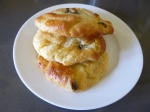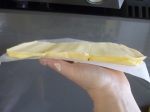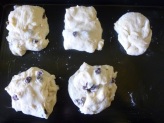It was a bank holiday. I’d allowed myself to indulge in the romantic notion of a leisurely breakfast of proper coffee, delectable homemade pastries and grown up conversation. A discussion about the pros and cons of staying in or leaving the EU perhaps. OK, that may be a bit too grown up for a bank holiday breakfast, just something a little bit more mature than, “I am dragon, Raah!” would do.
I should know by now. Romance and tricky baking simply do not mix. These flaccid, flabby, floppy – think I’d better stop with the f-words now – things are my attempt at pain au raisin.
 Actually, they don’t look that bad. Just nothing like pain au raisin. I was nearer tears with these than I have been since I made the disastrous dark chocolate savarin. Serves me right for dreaming about perfect pastries.
Actually, they don’t look that bad. Just nothing like pain au raisin. I was nearer tears with these than I have been since I made the disastrous dark chocolate savarin. Serves me right for dreaming about perfect pastries.
I’d decided to use a combination of books; James Martin’s Sweet for the crème pâtissière filling (I don’t think I’m quite experienced enough yet to call it crème pat) and the dough, and Edd Kimber’s Patisserie Made Simple for the assembly.
I started with the crème pâtissière which, I’m pleased to say worked really well, even though half of my vanilla seeds fell onto the floor whilst in transit across the kitchen (they still made it into the custard – far too expensive to waste – and, as my mom always says, a bit of dirt won’t hurt).
I boiled full fat milk with the vanilla, whisked eggs yolks and sugar together, and then added some cornflour. The next step was to pour the milk onto the egg mixture. I was nervous about this because the last time I made a custard with cornflour, there were lumps in it that wouldn’t have looked out of place in a rock garden. I added the milk slowly this time, and made sure that the mixture was smooth before I added more. I’m not sure whether this is the right thing to do, but it worked for me. I put everything back into my saucepan and stirred until the mixture started to thicken. A lovely smooth crème pâtissière. I sprinkled icing sugar over the surface, covered it with clingfilm and put it into the fridge. Things were looking good.
I moved onto the dough, a laminated enriched yeast dough no less; a yeasty puff pastry. I knew it was going to be tricky, but my confidence with enriched dough has increased lately after my Christmas garland and banana and Nutella bread so I was willing to give it a go.
My first problem was with the yeast. James Martin uses fresh yeast. I couldn’t find any so was using dried. Now, the recipe says that you should put the yeast into cold water and whisk it until it’s dissolved. Do you do the same for dried yeast, or do you need to activate it first? The instructions on the tin say that you should reactivate dried yeast before using it by mixing it with sugar and warm water, but it also says that, if the recipe calls for fresh yeast, simply replace it with half the quantity of dried yeast. Confusing. I pondered over my tin of yeast for a few minutes, then decided to follow the recipe and whisked the yeast into cold water. Just one of the reasons why my pastries may have failed.
I put my yeast and water into a mixture of strong flour, sugar and salt and then added cold water and mixed to a soft dough in the KitchenAid. I kneaded the dough for five minutes in the machine until it felt pretty stretchy and then rolled it out into a rectangle – well, a sort of rectangle. It was, in truth, more like an oval, but rolling dough that was so elastic was tricky, and neatness has never been one of my strongest points.
Next came the butter. James Martin takes 500g of butter and bashes it with a rolling-pin until it’s a 1cm thick 60cmx30cm rectangle. I was making half the quantity so, I took a block of butter, cut it into thirds, and went over the joins with a rolling-pin. I had a sort of rectangle, that was sort of 1cm thick.  I put my sort of butter rectangle in the middle of my sort of dough rectangle, folded one side of the dough over the butter, did the same with the other side, pinched the open ends together, and then folded the whole thing in half lengthways. I turned the dough through 90° and folded again. The butter was starting to soften and the dough starting to stick, so I put it into the fridge for a while, did a bit of ironing and then went through the folding process a couple more times. I wrapped the dough in clingfilm and put it into the fridge overnight (well, actually, it was in there for two nights – another reason perhaps why my pain au raisin weren’t great).
I put my sort of butter rectangle in the middle of my sort of dough rectangle, folded one side of the dough over the butter, did the same with the other side, pinched the open ends together, and then folded the whole thing in half lengthways. I turned the dough through 90° and folded again. The butter was starting to soften and the dough starting to stick, so I put it into the fridge for a while, did a bit of ironing and then went through the folding process a couple more times. I wrapped the dough in clingfilm and put it into the fridge overnight (well, actually, it was in there for two nights – another reason perhaps why my pain au raisin weren’t great).
To assemble the pastries, I turned to Edd Kimber’s book, Patisserie Made Simple. I rolled out the dough to another sort of rectangle, spread my crème pâtissière over the top, and sprinkled the whole thing with raisins, which I’d soaked in boiling water. Then I tried rolling it up. I couldn’t. Butter was seeping out of the dough making it stick on the work top. Custard was seeping out of the sides of my roll making everything slippery. I eventually managed a couple of turns, and cut the roll into slices. I put them onto greased baking sheets and left them to prove. There were no pain au raisin swirls, just lumps of custard-oozing dough. Oh dear.
James Martin leaves his pastries to prove for 30 minutes at room temperature before baking. Edd Kimber leaves his pain au raisin for two to three hours. I went with 30 minutes, mainly because I’d followed James Martin’s dough recipe so thought I’d stick with him for the proving times. There’s also no way that I’d have been able to wait another three hours for breakfast.
I baked the pastries – I can’t quite bring myself to call them pain au raisin – for 20 minutes at 180° fan, and you’ve seen what I ended up with. The custard was good, but the dough was dreadful. Floppy, damp, heavy, I can’t think of anything good to say about it, other than it wasn’t quite inedible. It’s going to be a very, very long time before I even think about homemade pastries for breakfast again.
The custard was good, but the dough was dreadful. Floppy, damp, heavy, I can’t think of anything good to say about it, other than it wasn’t quite inedible. It’s going to be a very, very long time before I even think about homemade pastries for breakfast again.

